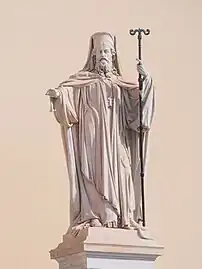Gregory V of Constantinople | |
|---|---|
 Gregory shortly before his murder, as depicted by Nikiphoros Lytras | |
| Ecumenical Patriarch, Hieromartyr | |
| Born | Georgios Angelopoulos 1746 Dimitsana, Ottoman Empire |
| Died | 22 April 1821 (aged 74–75) Constantinople, Ottoman Empire |
| Venerated in | Eastern Orthodox Church |
| Major shrine | Metropolitan Cathedral of Athens |
| Feast | 10 April |
| Controversy | elected in 1797 but deported to Mount Athos, Ottoman Empire in 1798, reelected 1806 and exiled to Prince Islands then Mount Athos in 1810, reelected 1818 |
Gregory V of Constantinople | |
|---|---|
| Ecumenical Patriarch of Constantinople | |
| Church | Church of Constantinople |
| In office |
|
| Predecessor | |
| Successor | |
Gregory V (Greek: Γρηγόριος; 1746 – 22 April 1821), born Georgios Angelopoulos (Γεώργιος Αγγελόπουλος), was Ecumenical Patriarch of Constantinople from 1797 to 1798, from 1806 to 1808, and from 1818 to 1821. He was responsible for much restoration work to the Patriarchal Cathedral of St George, which had been badly damaged by fire in 1738.
Biography
Born in Dimitsana, he studied in Athens for two years beginning in 1756, then moved to Smyrna for five more years of study. Tonsured as a monk with the name "Gregory" at the monastery in Strofades, he then studied at Patmiada School. Returning to Smyrna, he was ordained to the diaconate by Procopius who was Metropolitan of Smyrna at the time. In 1785, Gregory was consecrated as Metropolitan of Smyrna when Procopius was elected as Ecumenical Patriarch of Constantinople. In 1797, Gregory was first elected Ecumenical Patriarch upon the resignation of Gerasimus III.[1]
At the onset of the Greek War of Independence, as Ethnarch of the Orthodox Millet Gregory V was blamed by Ottoman Sultan Mahmud II for his inability to suppress the Greek uprising. This was in spite of the fact that Gregory had condemned the Greek revolutionary activities in order to protect the Greeks of Constantinople from such reprisals by the Ottoman Turks. After the Greek rebels scored several successes against the Ottoman forces in the Peloponnese, these reprisals came.
Directly after celebrating the solemn Paschal Liturgy on 22 April 1821 (10 April Old Style), Gregory was accosted by the Ottomans and, still in full liturgical vestments, was taken out of the Patriarchal Cathedral. He was then lynched, his corpse being left for two days on the main gate of the Patriarchate compound, all by order of the Sultan.[2] The Patriarch's body was eventually interred in the Metropolitan Cathedral of Athens. He is commemorated by the Greek Orthodox Church as an Ethnomartyr (Greek: Εθνομάρτυρας). In his memory, the Saint Peter Gate, once the main gate of the Patriarchate compound, was welded shut in 1821 and has remained shut ever since.
Influence
The brutal murder of Gregory V, especially on the day of Pascha, shocked and infuriated the Greeks, and Orthodox Russia. It also caused protests in the rest of Europe and reinforced the movement of Philhellenism. There are references that during the Greek War of Independence, many revolutionaries engraved on their swords the name of Gregory, seeking revenge.
Dionysios Solomos, in his "Hymn to Liberty", which later became the Greek national anthem, also mentions the hanging of the patriarch in some stanzas.
Jewish–Greek animosity
According to several accounts, after Gregory's death, his body, along with those of other executed prelates, was turned over to the city's Jews, who dragged it through the streets and threw it into the sea.[3][4] This led to several bloody reprisal attacks in southern Greece by the Greek rebels, who regarded the Jews as collaborators of the Turks. This in turn led to the Jews joining the Turks in attacks on Christians in some locations in northern Greece, which fueled a new wave of anti-Jewish attacks in the south.[4] During the night, the patriarch's corpse was recovered by Greek sailors, who brought it to Odessa.[3] After the funeral, some Greek sailors attacked Jewish shops which had remained open during the ceremony.[5]
In Odessa, then part of the Russian Empire, local Greeks committed what some sources consider the first Russian pogrom killing 14 Jews on the basis that Jews had taken part in Gregory's lynching.[6]
Gallery
 Saint Peter's Gate at the Patriarchate. Gregory V was lynched here. Since then the Gate has never been opened again.
Saint Peter's Gate at the Patriarchate. Gregory V was lynched here. Since then the Gate has never been opened again. Painting by Peter von Hess depicting the casting of the corpse of Patriarch Gregory V of Constantinople into the Bosphorus.
Painting by Peter von Hess depicting the casting of the corpse of Patriarch Gregory V of Constantinople into the Bosphorus. Statue of Grigorios (University of Athens) by Georgios Fytalis
Statue of Grigorios (University of Athens) by Georgios Fytalis The shrine of Patriarch Grigorios (Metropolitan Cathedral of Athens)
The shrine of Patriarch Grigorios (Metropolitan Cathedral of Athens)
References
- ↑ Metallinos, George (2019-09-03). "Γρηγόριος Ε´ (α) [10 Ἀπρ.]" [Gregory V (1) [10 Apr.]]. Ecumenical Patriarchate of Constantinople (in Greek). Archived from the original on 2022-04-11. Retrieved 2022-04-11.
- ↑ Mazower, Mark (2021). The Greek Revolution: 1821 and the Making of Modern Europe. New York City: Penguin Books. pp. 33–34. ISBN 9781591847335. OCLC 1246726205.
- 1 2 Fortescue, Adrian (1969) [1907]. The Orthodox Eastern Church. Medieval & Byzantine Series. Vol. 2 (Reprint ed.). Burt Franklin. p. 341. LCCN 79080232. OCLC 55918. OL 4433205M – via Internet Archive.
- 1 2 Fleming, Katherine Elizabeth (2008). Greece--a Jewish History. Princeton University Press. p. 16. ISBN 978-0-691-10272-6. OCLC 778036922. OL 22769720M.
- ↑ Orbach, Alexander (1980). New Voices of Russian Jewry: A Study of the Russian-Jewish Press of Odessa in the Era of the Great Reforms, 1860-1871. Studies in Judaism in modern times. Vol. 4. Brill Publishers. pp. 16–17. ISBN 9789004061750. LCCN 81106901. OCLC 929831506. OL 3802339M.
- ↑ Parkansky, Ariel. "Anti-Semitism and Pogroms". JewishGen. Archived from the original on 2014-10-06.